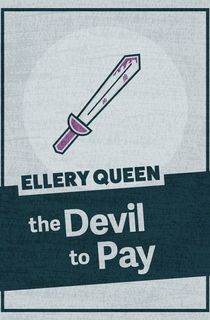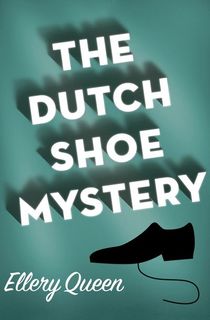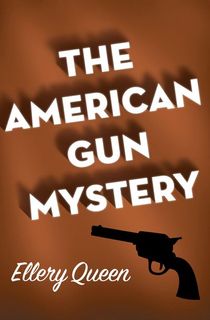Ellery Queen was one of the most influential mystery writers of the twentieth century. Or rather, he was two of the most influential, because Queen was, in fact, a pair of cousins from Brooklyn.
Back in the 1970s, television was overrun with detective shows—Kojak, Cannon, Mannix, Harry O, and Colombo to name just a random handful. Ellery Queen (starring Richard Hutton in the title role) stood out as a little different from the rest. Not only did Queen write stories such as The King is Dead, he was the main character in them, too. He was Holmes and Watson, Wolfe and Goodwin rolled into one.
Not only that, at the end of each episode, Queen addressed the audience directly, challenging the viewers to identify the criminal based on the events we had witnessed: “Have you got it? If you’ve been watching carefully, you may have seen something I missed until just now”. If we’d known a fourth wall existed back then, we’d have said he was breaking it. Each episode was a classic “fair play” mystery. And when the sleuth asked “Whodunit?” nobody watching could resist yelling out his or her answer.
But just who were the men behind Ellery Queen?

Ellery Queen had been doing exactly the same thing since 1929. His name was the pseudonym of two writers, Frederic Dannay and Manfred Benjamin Lee. To add another layer of confusion, those were in turn the pen names of Daniel Nathan and Emanuel Benjamin Lepofsky, cousins from Brooklyn. To complete the mischievous subterfuge early novels such as The French Powder Mystery came with an introduction written by Dannay and Lee under the name J J McC--. This claimed that Ellery Queen was a real person whose name had been changed and that since retiring he had been living in Italy with his wife and family.
The mischievous cousins had first collaborated as Ellery Queen to enter a magazine completion for the best mystery novel. They won, but the magazine folded before the novel saw print. Undeterred they found a publisher and The Roman Hat Mystery began a career that would see Ellery Queen producing 30 novels (more were written by – in another twist – a series of ghostwriters), 10 collections of short stories, radio series, movies, plays, TV shows, comic strips, and graphic novels. Queen also edited his own magazine (Ellery Queen’s Mystery Magazine) and a number of best-selling crime anthologies including the excellent Masters of Mystery. He designed board games and even jigsaw puzzles. Little wonder that at his peak in the 1940s, Ellery Queen was as synonymous with detection as Sherlock Holmes. Over their lifetimes Dannay and Lee would sell around 150 million books worldwide.

The Roman Hat Mystery
Though the locations of the stories moved from New York to Hollywood (starting with The Devil to Pay—in which Queen is called to the West Coast to write the screenplay of one of his novels, just as Dannay and Lee were doing… ) to the fictional East Coast town of Wrightsville (setting for the menacing Calamity Town) Dannay and Lee stuck to a winning formula of tautly plotted whodunits.
The set-up is simplicity itself. Ellery Queen is a sophisticated Harvard-educated author with a touch of the pretentious about him. He shares an apartment—in classics such as The Greek Coffin Mystery it’s on West 87th Street in Manhattan—with his widowed father, a tough New York Irish police inspector, Richard Queen (It’s hard not to see a parallel here with the characters of Frazier and Martin Crane in the long-running sitcom, Frazier), whose contacts help Ellery gain access to otherwise privileged information.

The Devil to Pay

The Greek Coffin Mystery
The mysteries—including a classic locked room case The Door Between—begin with an unusual and complex crime, there are dozens of well-constructed clues, plenty of misdirection, and a shoal of red herrings. The intricate logic is maintained throughout whether the setting is a hospital (The Dutch Shoe Mystery) or a rodeo (The American Gun Mystery). The reader witnesses everything Queen does. There is only one possible answer to the puzzle. Just as in the TV show, readers are invited to solve the mystery faster than the writer-sleuth: “Well, I think I know what happened. Do you?”

The Dutch Shoe Mystery

The American Gun Mystery
For writers collaborating can be a tricky business involving clashes of ego, arguments and the occasional acrimonious bust-up. However, Dannay and Lee seem to have slotted together pretty seamlessly from the start. The former came up with the plots and the clues. The latter filled them out with descriptive passages and dialogue, including Ellery Queen’s many witty epigrams on life and crime.
Ellery Queen’s workload was prodigious. Perhaps it took its toll. After completing The Finishing Stroke in 1959, Lee suffered a series of heart attacks. Other Ellery Queen novels would appear—commencing with The Player on the Side in 1963—but all were penned by other hands under the guidance of the cousins. The last title, A Fine and Private Place was published in 1971, the year that Lee died. No further Ellery Queen mysteries appeared after that.

A Fine and Private Place

The Player on the Other Side
Dannay continued to edit the Ellery Queen Magazine (which is still going strong today). He died in 1986. Reviewing their work one of Britain’s Queens of Crime Margery Allingham commented that Dannay and Lee had done more for the detective novel than any two men in history, while US mystery writer Anthony Boucher summarised, “Ellery Queen is the American detective novel”.
Perhaps more important than their own fictional creation, was the fact that through their anthologies and their magazine, Dannay and Lee introduced readers to hundreds of new crime writers from all around the world. They were the genre's greatest promoters, true evangelists of mystery fiction
.jpg?w=3840)